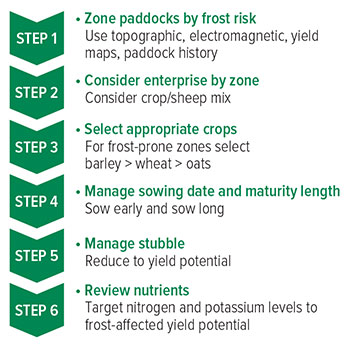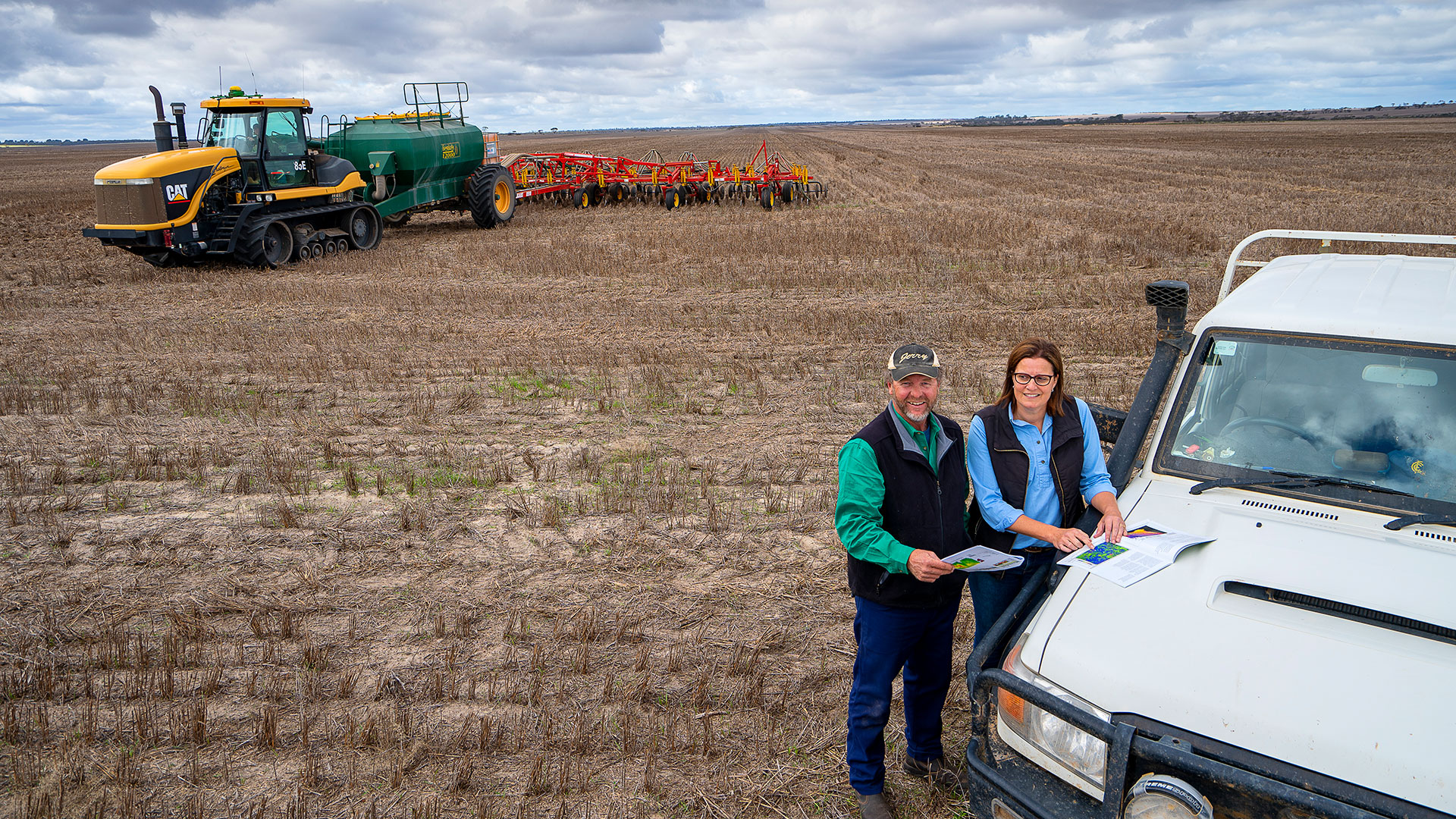Key points
- Although frost is a complex crop production constraint, management tactics can be customised to risk zones to reduce the financial impact
- Having a pre-season frost management plan and reviewing it each season can boost confidence and profit
- Peer-to-peer learning can provide new ideas and reinforce management plans for frost
The complex, unpredictable and sudden nature of frost makes it a challenging problem. While a simple problem can be solved by choosing and applying the correct decision algorithm, a complex problem has no known single algorithm to solve it.
It is the nature of this challenge and the significant effect it can have on growers’ livelihoods that drives Dr Ben Biddulph to continue his research team’s pursuit to develop management strategies for Western Australian growers.
Over the previous GRDC National Frost Initiative investment, the Department of Primary Industries and Regional Development (DPIRD) and WA research partners (Living Farm, Facey Group, WA No-Tillage Farmers Association, Murdoch University and ConsultAg) led a range of trials that have generated data to underpin several frost risk management strategies.
 Garren Knell, of ConsultAg, (top left) working with growers Shaun Wisewould (right) and Chad Sounness mapping frost zone risk areas on their farm maps at the Needilup workshop hosted by Fitzgerald Biosphere Group. Photo: GGA
Garren Knell, of ConsultAg, (top left) working with growers Shaun Wisewould (right) and Chad Sounness mapping frost zone risk areas on their farm maps at the Needilup workshop hosted by Fitzgerald Biosphere Group. Photo: GGA
The financial benefits of oats and barley over wheat across a range of sowing windows in frost-prone landscapes with low, medium and high yield potential have been well-established. The value of potash and in-season nitrogen, together with managing stubble loads at seeding, have also been confirmed to be sound management strategies to reduce the impacts of frost.
This season, Mark Holland (Grower Group Alliance) assembled a team including Dr Biddulph (DPIRD), Garren Knell and Jordy Medlen (ConsultAg), Sarah Hyde (Facey Group) and producers Ashton Gray (Lakes Grower Group), Gary Lang (Facey Grower Group) and Brent Hyde (Holt Rock Grower Group). The team presented their experiences to extend and apply outcomes of previous frost research and proven risk management strategies through a suite of GRDC-invested workshops, convened locally by seven grower groups across the grain regions.
Dr Biddulph has been one of the instigators of previous travelling frost workshops, together with Mr Knell, but this season’s workshops were different. Robust trial data showing the improvements in grain yield under frost risk management strategies, together with the economics, were presented.
“This year, it was not just the scientists telling the farmers what the latest results were, as the events also involved growers sharing their learnings about adapting and customising their frost management as a result of the research,” Dr Biddulph says.
“Growers take a direct hit in the hip pocket when frost strikes and sharing their lived experiences about adopting new risk management practices through peer-to-peer learning can be a very powerful tool to illustrate the success of adopting practice change.”
Ninety-four growers and 22 consultants attended the seven workshops, which extended from Bruce Rock to Salmon Gums and Kojonup. Some workshops were located in less-traditional frost areas to accommodate growers experiencing the more-intense and frequent frosts that are extending north, south and west of the traditional frosty regions of the wheatbelt.
 Figure 1: Hierarchical management strategies for frost. Source: GRDC
Figure 1: Hierarchical management strategies for frost. Source: GRDC
As frost is such a complex constraint to manage, Dr Biddulph encourages growers to consider their personal approach to risk, as this is very individual.
“As part of this review process, identify and measure the extent of the risk, evaluate risk management alternatives and tailor the management intervention according to the risk level that you are comfortable with,” Dr Biddulph says (see Figure 1).
“The risk of frost can often drive conservative farming practices, which should be carefully and regularly reviewed in light of the latest research.”
Mr Knell says the interactive and pre-sowing timing of the workshops was an excellent means for growers to review their frost management strategies and commit to making a change. “Zoning paddocks according to frost risk and managing them accordingly is probably one of the biggest tools in a grower’s frost management toolkit,” he says.
What’s happening with frost?
Dr Biddulph set the scene for each workshop by illustrating the changes in frost, heat, season break and growing-season rainfall for the grain producing regions of WA.
DPIRD has been mapping extreme events such as frost and heat for many years. Through this mapping, it has found that the South West Land Division of WA (SWLD) experienced a climate shift in the mid-1970s. Since 2000, along with a rainfall decline of 28 per cent in May to June, there has also been an increase in the number of extreme temperature events. It is increasingly important that producers maximise the probability of their crops flowering in the ‘sweet spot’ between frost and heat events.
DPIRD has found that the total number of frost occurrences (days below 2˚C) in August to October in the SWLD has increased (Figure 2) and the number of heat events (days over 30˚C) has also increased with the changing climate. In addition, since 2000 frost is also now more widespread in the SWLD (Figure 2). The timing of these events corresponds to flowering and grain fill of cereals and oilseeds and, therefore, has a significant negative impact on growers’ businesses.
Figure 2: Expanding incidence of frost (<2°C) in August and October in the South-West Land Division of WA from (a) 1975–99 to (b) 2000–20, produced using patched point technology and DPIRD weather station data. Black dots indicate a weather station.

Source: DPIRD
“Not only are heat and frost incidence increasing and the frost region expanding both north and south, but rainfall is declining,” Dr Biddulph says.
“But growers are sowing earlier, and as temperature increases, these crops can flower up to a month earlier. Compounding this is the fact that growers are not sowing as many long-season varieties compared to 10 to 20 years ago."
“As there is less livestock included in many enterprises, this means there is potentially a larger financial impact when frost hits. It’s even worse when crops are exposed to a series of frosts.
“Without the silver bullet of a frost-resistant wheat, growers need to do a comprehensive review of their frost-risk management strategies and these pre-sowing workshops provided an excellent forum to evaluate their options with greater clarity and objectivity with frost experts at hand.”
Lived experience
Ashton Gray, who farms with his family at Tarin Rock near Lake Grace, shared his lived experience managing frost with participants at the workshops held at Needilup and Borden.
Ashton experienced the effects of frost as a child, riding in the family harvester, and says it is etched into his memory.
“Some years when we harvested the ‘valley floors’ around our property, I would watch large amounts of dry matter enter the header front and nothing go into the hopper. I didn’t understand what was going on,” he says.
Ashton is now very much wiser. After completing a degree in agricultural science at The University of Western Australia, he gained seven years of experience consulting with Mr Knell’s ConsultAg business – around WA’s lakes region.
“This gave me insights into a wide range of industry research and development, being involved with some of the frost research first-hand, as well as invaluable access to local farm enterprises, which has shaped the management practices we now use on our property,” he says.
It also gave him an appreciation for the power of peer-to-peer learning to improve the adoption of practice change and a desire to give back to his local industry. He does this as the president of the Lakes Information and Farming Technology Group – a member of the Grower Group Alliance – and through activities such as the frost workshops.
Ashton is a fourth-generation grower who works with a team – brother Kael, sister Tahryn and her husband Damian. Their mixed cropping (70 per cent) and livestock (30 per cent) enterprise is on 7500 hectares of owned and leased country, a proportion of which is low-lying valley floor country prone to frost.
“Management is very much a collective effort, and we are building on the cropping experience and insights of previous generations.”
“As the regional climate has changed over the years and we are seeing more frequent and severe frosts, we have pieced together frost management research and experience and totally changed the farming system.”
The new management approach has required a shift in mentality for Ashton and his family with a focus on zoning, crop rotation, and times of sowing.
“Our number one tool is zoning country for frost risk. Then deciding on enterprise, crop species per zone and then careful variety selection and time of sowing,” Ashton says.
“Canola is grown high in the landscape and oats in the low-lying, frost-prone areas. The highest-frost-risk areas are sown to pasture.”
The Grays’ cropping program breakdown is 40 per cent barley (three varieties), 15 per cent oats (two varieties), 10 per cent wheat (one variety), five per cent canola and five per cent lupins, along with 25 per cent pasture and fodder (including export and possibly frosted crop).
“In the last three years the property has received under 200 millimetres of growing-season rainfall and, despite this low rainfall, our most profitable crops have been oats followed by barley. The adoption of dry-sowing oats has certainly been a key to this crop’s success,” Ashton says.
“Where we used to have a 70 per cent wheat rotation and the rest was everything else, now everything else is 75 per cent and wheat is very much the minority."
“Sowing time now starts a month to six weeks earlier than traditionally and we aim to finish around 30 May, spreading sowing over six weeks starting with canola then lupins, oats, hay, long-season barley, mid-season barley, then finally wheat.
“We maintain a fair amount of grain storage. This historically has been used for sheep feed, but it now gives us more flexibility to store more crop types on-farm for both sowing and to retain harvested grain to sell at more opportune times.”
The Grays keep watch for new variety releases and are bulking up the quick to mid-maturing Maximus CL and CommodusCL barleys to replace Spartacus CL and Scope CL respectively, which he pairs with the early maturity Fathom barley. Wheat is maintained in the program primarily for market diversity but also herbicide diversity, with Scepter being the variety used.
Wandering oats (released in 1999) is the mainstay of his oat program as it is a robust variety and resilient in dry finishes, maintaining good grain weight. However, the Grays also grow some Bannister oats.
“I’m watching new developments in oat breeding in WA with interest, as improved crop genetics are key for our system to maximise productivity,” Ashton says.
He was intrigued to learn about Dr Biddulph’s new work on ice-nucleating bacteria (Pseudomonas spp) at the workshop and is curious to see this area of research unfold and the management implications for growers. This research is gaining understanding on how these bacteria contribute to increasing the freezing point of water, heightening the risk of frost damage to wet crops after slow moving cold fronts. The research is supported by the Department of Primary Industries and Regional Development, funded by the Council of Grain Growers Organisations (COGGO).
His message to growers is to keep an open mind about frost and be flexible around new ideas, as there is no simple solution.
Frost zone strategies
Mr Knell has spent decades working with his clients as well as delivering GRDC-invested frost management workshops to hone growers’ frost management skills. He says avoiding frost comes at a cost.
“You need to know your risk for each paddock in order to know what strategies to apply,” he says.
“To do this you must know the historical risk of frost in your region, document your experiences with it over these seasons and then look carefully at your land, assessing paddock by paddock.
“Be aware of soil types and the position of paddocks in the landscape and adapt the management strategy to the risk.”
Mr Knell challenged workshop attendees on their equipment and infrastructure purchases. “In frost-prone regions, after zoning your property for frost risk, one of your biggest management tools is crop species and varieties, so you are better off investing in grain storage to have more of these genetic tools at the ready,” he says. “For today’s farming system we need tools to capitalise on early breaks to the season and we also need the correct varieties for dry, late-break years.”
He says it is also important to match inputs to realistic yields for high-risk paddocks. Potassium is a key nutrient to review, both pre-season and in-season, as it plays a role in maintaining cell water content in plants, which can potentially influence tolerance to frost.
Management strategies for frost-risk zoned paddocks
Low-risk paddocks
- Ignore frost and aim for maximum production
Medium-risk paddocks
- Match time of sowing to variety maturity
- If sowing early, use longer-maturity varieties
- Consider widening rotation and grow less-risky crops, such as oats or long-season barley
- Ensure adequate potassium on low-potassium soils
High-risk paddocks
- Review crop rotation: more pasture, fodder, hay, oats and barley
- Review time of sowing for each species and variety
- Match inputs to realistic yields
- Consider crop tolerance of frost and match inputs
- Consider grazing crops – this is the only way to change flowering time after seeding; graze early and use the rule that two weeks’ grazing changes flowering by one week
- Consider ameliorating soils– this improves wettability of soils, soil water holding capacity improving yield.
- Review stubble management practices: heavy stubble loads can increase the severity of a cold night and heavy stubble loads, particularly canola stalks, can preclude making export hay as a salvage option
Source: ConsultAg
Putting zoning into practice
Quentin and Natasha Brown farm near Needilup and attended the Needilup workshop.
The Browns crop 3700ha of their 4500ha enterprise and in the past four years have seen frost significantly affect their bottom line through an increased number of seasonal frosts and the cumulative effect of the damage.
Quentin and Natasha Brown who farm near Needilup and have been experiencing more frosts in recent years have revised their sowing program to reduce the amount of wheat, after attending the Needilup pre-sowing frost workshop

Quentin and Natasha Brown who farm near Needilup and have been experiencing more frosts in recent years have revised their sowing program to reduce the amount of wheat, after attending the Needilup pre-sowing frost workshop. Photo: Evan Collis
“We simply had to make the time to attend the workshop to upskill our frost management,” Quentin says.
In recent years, Quentin and Tash have reviewed their crop rotation and reduced the amount of wheat they produce.
“It’s taken a mindset change to reduce wheat and our rotation now is lupins/oats/canola/barley/barley – and the workshop discussion confirmed that we were on the right track by doing this,” Quentin says.
“We were taken through an exercise at the workshop where we mapped our cropping country into low, medium and high frost-risk regions. This was done by considering the elevation of the paddock and the soil type. Often the lighter soil types were where we incurred more-severe frosts.
“We then assessed each paddock in terms of how best to manage it according to its frost risk. Where the economics stacked up and where there were other system benefits, we would consider deep ripping and delving to bring up clay to increase moisture retention of some high-risk paddocks.”
With help from frost experts at the workshop, the Browns worked through the crop and variety choice according to paddocks’ risk status and then appropriate time of sowing.
“The exercise certainly was a confidence booster for managing what is an intractable constraint and it certainly put things into context hearing from the lived experience of more frost-seasoned growers,” Tash says.
Enacting their plan this season, the Browns sowed more barley and even less wheat over a larger sowing window. They alternated between barley and wheat towards the end of their sowing program and finished at the end of May. They used the quick-maturing barley Spartacus CL and the mid-fast spring Mace, together with the mid-long spring Zen wheat.
One of their biggest takeaways from the workshop, Tash says, was for them to do more monitoring of crops throughout the season and to learn how to identify the signs and extent of frost damage.
“This would help us better gauge when to cut damaged crops for hay,” she says.
Wrap-up
Dr Biddulph said the participants had an established ability to map their properties into frost risk categories. “Growers know from years of experience where their high frost risk areas are and this certainly made the zoning exercise easy,” he says.
“Then, taking Garren’s approach to matching management strategy to zone was a real confidence-booster for growers, in particular those who were new to managing frost.”
Mr Knell says growers have no influence over frost timing and severity. “But you can influence your exposure to any given event by mapping frost-prone areas and selecting crop species, variety and time of sowing with care.”
More information: GRDC Frost management.

























































